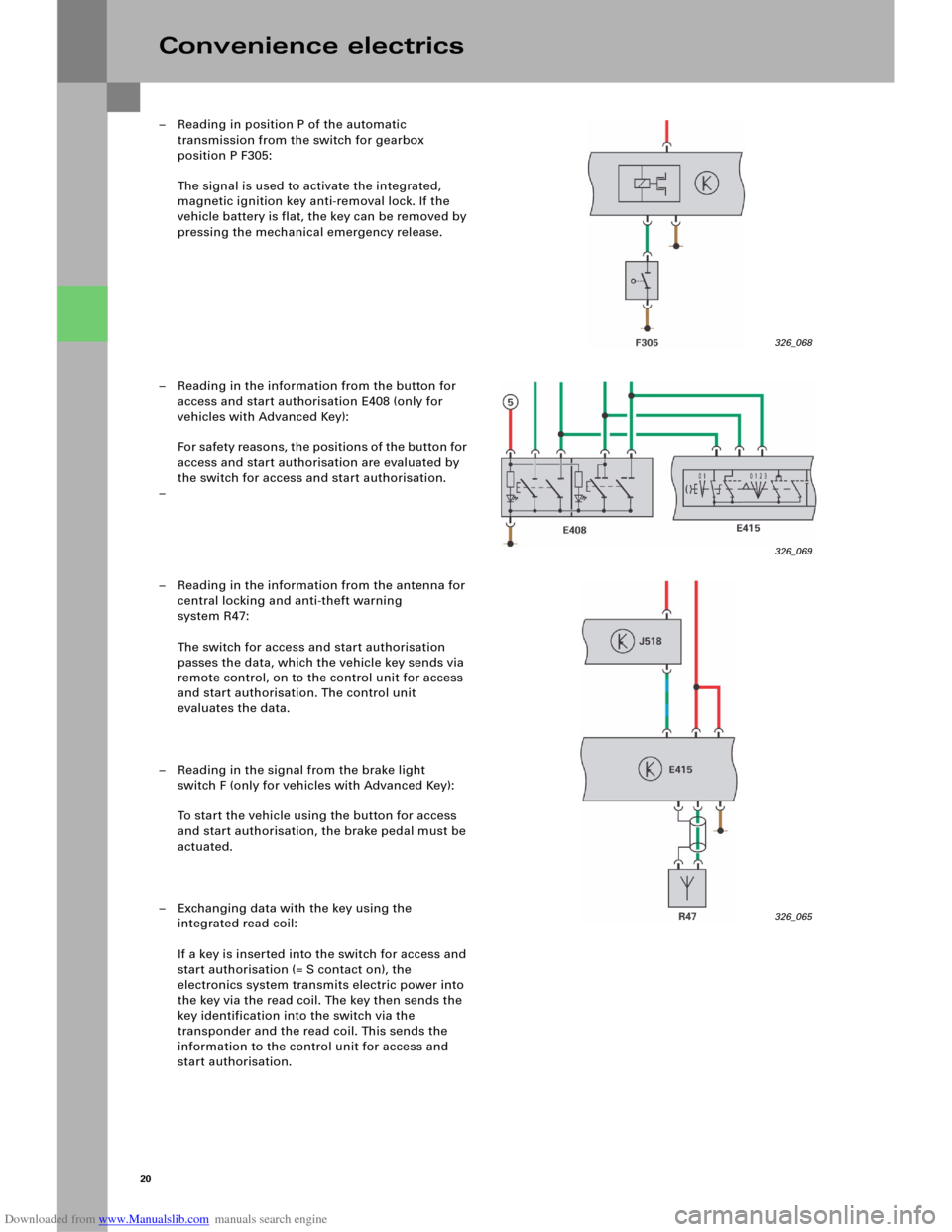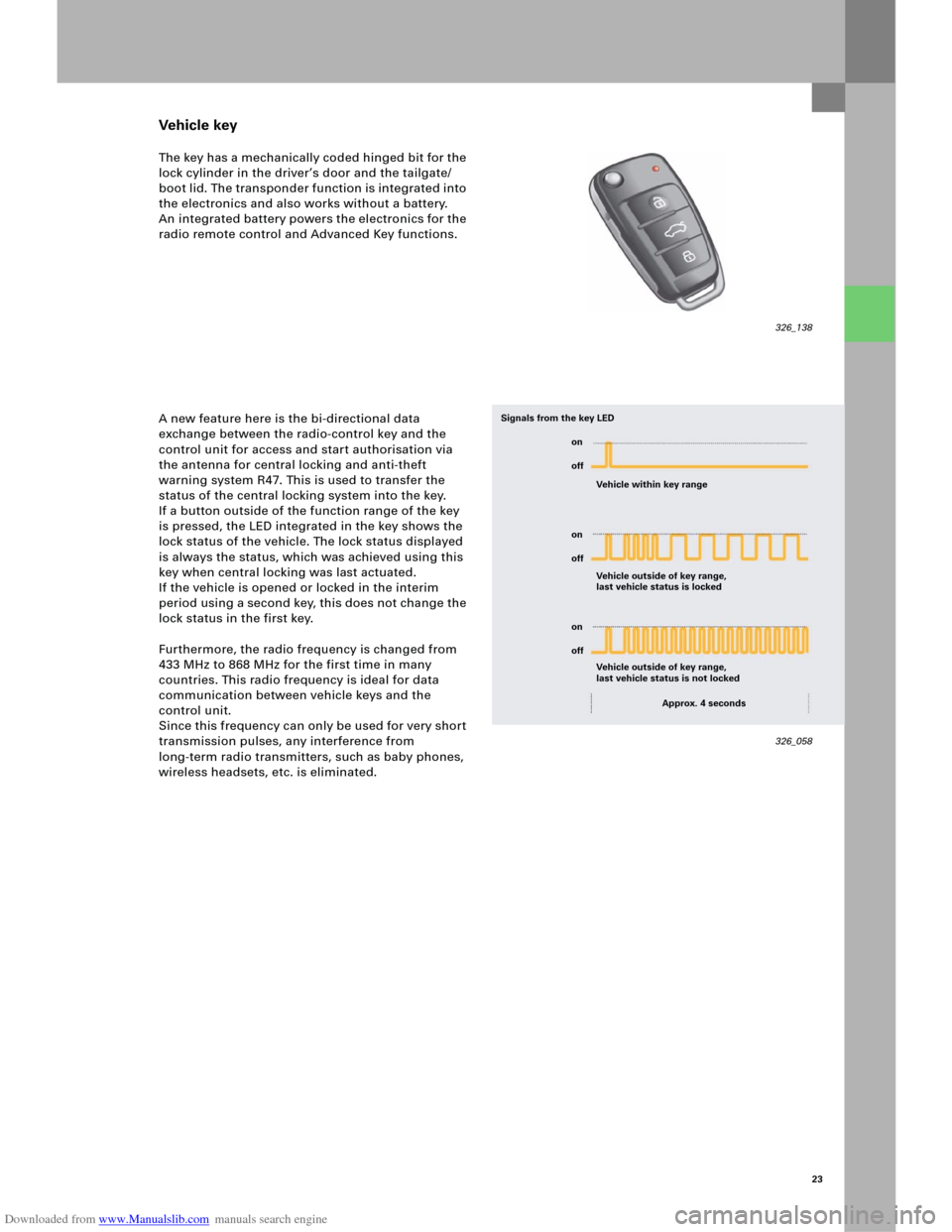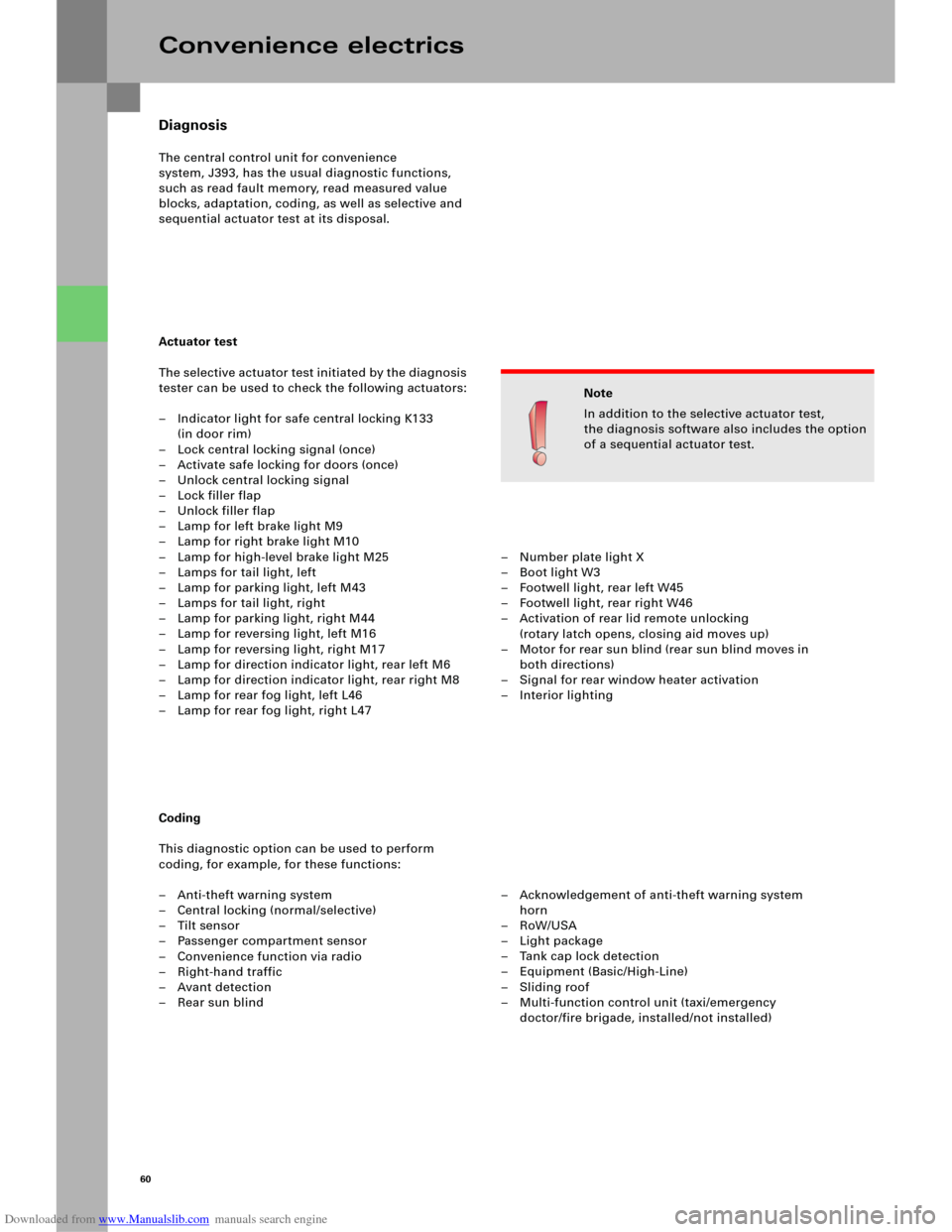remote control AUDI A6 2005 C5 / 2.G Electrics System Training Manual
[x] Cancel search | Manufacturer: AUDI, Model Year: 2005, Model line: A6, Model: AUDI A6 2005 C5 / 2.GPages: 92, PDF Size: 4.42 MB
Page 18 of 92

Downloaded from www.Manualslib.com manuals search engine 20
– Reading in position P of the automatic
transmission from the switch for gearbox
position P F305:
The signal is used to activate the integrated,
magnetic ignition key anti-removal lock. If the
vehicle battery is flat, the key can be removed by
pressing the mechanical emergency release.
– Reading in the information from the button for
access and start authorisation E408 (only for
vehicles with Advanced Key):
Fo r s a fe t y r e as o n s , t h e p o s i t i o n s o f t h e b u t to n fo r
access and start authorisation are evaluated by
the switch for access and start authorisation.
–
– Reading in the information from the antenna for
central locking and anti-theft warning
system R47:
The switch for access and start authorisation
passes the data, which the vehicle key sends via
remote control, on to the control unit for access
and start authorisation. The control unit
evaluates the data.
– Reading in the signal from the brake light
switch F (only for vehicles with Advanced Key):
To start the vehicle using the button for access
and start authorisation, the brake pedal must be
actuated.
– Exchanging data with the key using the
integrated read coil:
If a key is inserted into the switch for access and
start authorisation (= S contact on), the
electronics system transmits electric power into
the key via the read coil. The key then sends the
key identification into the switch via the
transponder and the read coil. This sends the
information to the control unit for access and
start authorisation.
Convenience electrics
326_069 326_068
326_065
Page 21 of 92

Downloaded from www.Manualslib.com manuals search engine 23
Vehicl e ke y
The key has a mechanically coded hinged bit for the
lock cylinder in the driver’s door and the tailgate/
boot lid. The transponder function is integrated into
the electronics and also works without a battery.
An integrated battery powers the electronics for the
radio remote control and Advanced Key functions.
A new feature here is the bi-directional data
exchange between the radio-control key and the
control unit for access and start authorisation via
the antenna for central locking and anti-theft
warning system R47. This is used to transfer the
status of the central locking system into the key.
If a button outside of the function range of the key
is pressed, the LED integrated in the key shows the
lock status of the vehicle. The lock status displayed
is always the status, which was achieved using this
key when central locking was last actuated.
If the vehicle is opened or locked in the interim
period using a second key, this does not change the
lock status in the first key.
Furthermore, the radio frequency is changed from
433 MHz to 868 MHz for the first time in many
countries. This radio frequency is ideal for data
communication between vehicle keys and the
control unit.
Since this frequency can only be used for very short
transmission pulses, any interference from
long-term radio transmitters, such as baby phones,
wireless headsets, etc. is eliminated.
326_138
326_058 Vehicle within key range
Vehicle outside of key range,
last vehicle status is locked Signals from the key LED
Vehicle outside of key range,
last vehicle status is not locked
Approx. 4 seconds on
off
on
off
on
off
Page 58 of 92

Downloaded from www.Manualslib.com manuals search engine 60
Diagnosis
The central control unit for convenience
system, J393, has the usual diagnostic functions,
such as read fault memory, read measured value
blocks, adaptation, coding, as well as selective and
sequential actuator test at its disposal.
Actuator test
The selective actuator test initiated by the diagnosis
tester can be used to check the following actuators:
– Indicator light for safe central locking K133
(in door rim)
– Lock central locking signal (once)
– Activate safe locking for doors (once)
– Unlock central locking signal
– Lock filler flap
– Unlock filler flap
– Lamp for left brake light M9
– Lamp for right brake light M10
– Lamp for high-level brake light M25
– Lamps for tail light, left
– Lamp for parking light, left M43
– Lamps for tail light, right
– Lamp for parking light, right M44
– Lamp for reversing light, left M16
– Lamp for reversing light, right M17
– Lamp for direction indicator light, rear left M6
– Lamp for direction indicator light, rear right M8
– Lamp for rear fog light, left L46
– Lamp for rear fog light, right L47
Coding
This diagnostic option can be used to perform
coding, for example, for these functions:
– Anti-theft warning system
– Central locking (normal/selective)
–Tilt sensor
– Passenger compartment sensor
– Convenience function via radio
–Right-hand traffic
–Avant detection
–Rear sun blind
Convenience electrics
Note
In addition to the selective actuator test,
the diagnosis software also includes the option
of a sequential actuator test.
– Number plate light X
– Boot light W3
– Footwell light, rear left W45
– Footwell light, rear right W46
– Activation of rear lid remote unlocking
(rotary latch opens, closing aid moves up)
– Motor for rear sun blind (rear sun blind moves in
both directions)
– Signal for rear window heater activation
–Interior lighting
– Acknowledgement of anti-theft warning system
horn
–RoW/USA
–Light package
– Tank cap lock detection
– Equipment (Basic/High-Line)
–Sliding roof
– Multi-function control unit (taxi/emergency
doctor/fire brigade, installed/not installed)
Page 61 of 92

Downloaded from www.Manualslib.com manuals search engine 63
The door control units have a similar functionality to
those used in the Audi A8 ´03 and are used in the
Audi A6 ’05 with appropriately adapted functions
and actuation features.
The separate installation of the door control unit
and the power windows motor is new here.
Stand-by master function
As in the Audi A8 ´03, the door control unit on the
driver’s side J386 controls central locking if the
central control unit for the convenience system
J393 fails. If there is no co mmunic atio n b etw een the
driver’s-side door control unit J386 and the central
control unit for the convenience system J393, the
other door control units evaluate the information
from the driver’s-side door control unit directly.
In this case, it is no longer possible to open the
vehicle via remote control or Advanced Key.
Diagnosis
The address words 42, 52, 62 and 72 "Door
electronics" offer diagnostic options, such as
measured-block reading, coding or the selective /
sequential actuator test (the selective actuator test
is used for the targeted activation of actuators).
Versi on s
Low-Line and High-Line versions of the door control
units are used.
The High-Line version includes the following
functions, for example:
– Advanced Key
– Memory switch block
– Ambient lighting
–Area lighting
–Folding mirrors
– Automatic anti-dazzle mirror
– Electric child-lock
Installation position of driver’s-side door control unit J386326_139
Door control units J386 - J389
326_102
Page 62 of 92

Downloaded from www.Manualslib.com manuals search engine 64
System overview
Convenience electrics
– Power windows switch
– Internal locking switch
– Actuating elements for central locking
– Actuating elements for central locking
(Safe mode)
– Outer door handle switch (optional)
– Central locking button for outer door handle
– Boot release switch E164– Switch for remote unlocking and
filler flap E204
–Child-lock button E318
– Mirror adjustment change-over switch E48
–Mirror adjustment switch E43
– Mirror adjustment switch with
folding function E168
– Switch for alarm system off E217 (optional)
– Switch for passenger compartment monitoring
(optional) E183
Additional signals for front doors
– Operator unit for memory
– Mirror position sensor
Additional loads for driver’s door
– Contact switch in lock barrel
driver’s side F241
– Central locking motors
– Central locking motors (Safe mode)
– Door warning lights
–Entry lights
– Lighting for inside door handle
– Ambient lighting for doors (optional)Additional loads for front doors
– Mirror adjustment motors
– Mirror folding motors
– Heated door mirrors
– Automatic anti-dazzle mirror
– Entry light in door mirror,
driver’s side and passenger’s side
Additional loads for rear doors
–Lamp for rear ashtray lightAdditional loads for driver’s door
– Lock status LED for passenger’s door
– Indicator light for safe central locking
– Indicator light for tilt sensor K188
(optional)
– Indicator light for passenger compartment
monitoring deactivation K162 (optional)
– Indicator light for memory SET
326_109
The door control units receive the following input signals:
The door control units activate the following loads:
Page 73 of 92

Downloaded from www.Manualslib.com manuals search engine 75
Antenna systems
The antenna system in the new Audi A6 ´05 is
integrated as a module in the top area of the rear
window, to the left and next to the third brake light,
on the right.
The modules are responsible for the various
s y s t e m s, e . g . re m o t e c e n t ral lo ck i n g , rad i o , T V o r t h e
radio receiver for the auxiliary heater.
Only the modules that are required for the
requested optional extras are installed.The table shows the relevant modules for the
available vehicle equipment. These are indicated for
the various, worldwide country versions.
The modules "DAB" and "SDARS" relate to the digital
radio systems, which will be available later and are
based on either a satellite-controlled system
(SDARS) or a terrestrial system (DAB).
ModuleDesignationAvailable in market version
1
1
1
1
2
4
2
2
2
3
4
5
5
5
5
7
8Radio AM/FM
Radio AM/FM-Diversity
Radio AM/FM-Div/TV
Radio AM/FM-Div/TV
Remote central locking
Remote control for auxiliary heater
Remote locking/TV
Remote locking/TV/DAB
Remote central locking/TV
Navigation
Mobile phone-US
Te l e p h o n e E C E
Telephone (fixed or mobile)/Navigation
Telephone/Navigation
Satellite radio
Block circuit
Te l e p a s sECE
ECE/US
ECE/US
Japan
ECE/US
ECE
ECE/US
ECE
Japan
RoW
US
ECE
ECE
US
US
Italy
Installed antenna modules for possible vehicle equipment
Module 1
Module 3 Module 4Module 2 Module 5
Module 7Module 6
A
M
/F
M
-Di
v/
TV
1-2Third brake lightT
V3-
4
/R
emot
e
c
ent
ra
l
locking/R
C
/DA
B
326_125
Module 1: Radio/antenna amplifier R24
Module 2: Remote central locking/antenna amplifier 2 R111
Module 3: GPS/antenna for GPS navigation R50
Module 4: Mobile phone antenna USA/Antenna for telephone,
navigation, auxiliary heater R66Module 5: Roof antenna/antenna for radio, telephone,
navigation R52
Module 6: Block circuit
Module 7: Telepass antenna
Page 77 of 92

Downloaded from www.Manualslib.com manuals search engine 79
Overview of the measured-value blocks available
for the individual modules
ModuleDesignation
General measured-value blocks
for all modulesGeneral: Battery positive voltage, terminal status
MOST: Address, MOST FOT temperature, optical lowering
Status of ring break diagnosis line
Control unit identification:
Serial number, flash date, hardware and software version
Control unit for front information
J523Multimedia operating unit E380: Status of main buttons, status of knobs/pushbuttons,
volume controller status
Display: LCD display temperature
Signals: Terminal 58D, terminal 58S
Integrated amplifier,
2x20-wattStatus of input signals, status of mute lead, speed (GALA), temperature
Radio RRemote-feed antenna: Open circuit, OK, short circuit
Remote-feed ZF output: Open circuit, OK, short circuit
Transmitter receive-level (0... 100 dBµV)
CD ROM drive R92CD status: Button status (Play, Stop, etc.), Eject button status, status of functions (Repeat, Scan, etc.)
Control unit for navigation
with CD drive J401Route Info: Speed, direction of travel
GPS: Satellites received, status of remote-feed GPS antenna OK, short circuit, open circuit
GPS FIX: GPS information on satellite reception and position-finding
Drive: Status of CD drive, incorrect or no navigation CD inserted, Load Eject error,
CD drive overheating
Status of navigation CD
Longitude corrected: Arc degree, arc minute, arc second
Latitude corrected: Degree of longitude, minute of longitude, second of longitude
Height and angle of direction corrected: Height in metres, angle of direction in degrees
GPS date: Day, month, year or "invalid" if there is no GPS reception
GPS time: Hour, minute, second or "invalid" if there is no GPS reception
Front axle distance pulses, status
GPS level 1: Satellite ID with best and second-best reception
GPS level 2: Satellite ID with third-best reception